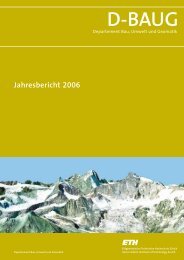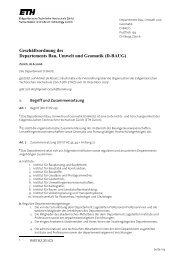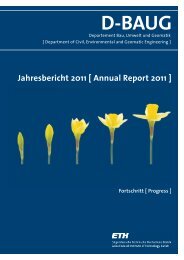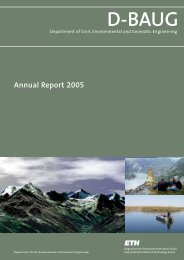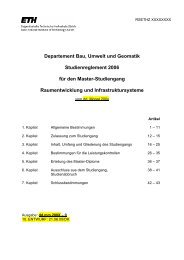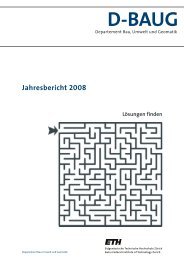D-BAUG - Departement Bau, Umwelt und Geomatik - ETH Zürich
D-BAUG - Departement Bau, Umwelt und Geomatik - ETH Zürich
D-BAUG - Departement Bau, Umwelt und Geomatik - ETH Zürich
You also want an ePaper? Increase the reach of your titles
YUMPU automatically turns print PDFs into web optimized ePapers that Google loves.
Highlights ▪ Resources<br />
Flood control measures at the “Kleine<br />
Emme” River<br />
Physical experiments on drift wood retention<br />
at the‘Kleine Emme’River near Malters,<br />
Canton Lucerne.<br />
The 2005 flood event caused large damages in many regions<br />
in Switzerland and so in the area of the Kleine Emme<br />
River. Initiated by this event, a combined approach including<br />
hydro power production and drift wood retention with<br />
a diversion channel and a drift wood rack (Fig. 1) for the<br />
Malters river stretch at the Kleine Emme has been projected.<br />
The Canton Lucerne has assigned the VAW to test<br />
and optimize the given configuration with the help of a<br />
physical model on a 1:50 scale with focus on flood protection<br />
aspects and the efficiency of the drift wood retention.<br />
The experiments showed that, with the given configuration,<br />
the intended efficiency of 50 % of retained drift wood<br />
can be achieved; however, certain flood protection aspects<br />
were not fulfilled.To improve the situation, a new concept<br />
regarding the direction of the approach flow towards the<br />
drift wood rack (parallel instead of frontal approach flow)<br />
(Fig. 2) has been tested.The parallel approach flow in combination<br />
with an area of recirculating flow, led to the same<br />
efficiency of retained drift wood, plus strongly improved<br />
flood safety conditions.This improvement can be explained<br />
by a reduced tendency of the drift wood for piling up in<br />
front of the drift wood rack with parallel approach flow,<br />
leading to reduced backwater effects.<br />
The final design includes a second drift wood rack downstream<br />
of the first one, which increases the drift wood retention<br />
efficiency by approximately 10 %, resulting in a total<br />
retention efficiency of roughly 2/3 of the oncoming<br />
drift wood.<br />
62 ▪ D-<strong>BAUG</strong> Annual Report 2009<br />
Flood protection project “Linth 2000”<br />
Hybrid modelling of a spillway to prevent<br />
dam breaks at the Linth Canal.<br />
by S. Tamagni, V. Weitbrecht / VAW by P. Seitz, Th. Berchtold, V. Weitbrecht, D. Vetsch / VAW<br />
Since river engineering and flood protection concepts are<br />
designed to work properly not only <strong>und</strong>er design conditions,<br />
but as well for the overload scenario, the flood protection<br />
project “Linth 2000” is investigated at the VAW using<br />
a hybrid modelling approach, where physical and<br />
numerical experiments are combined. A regulated overfall<br />
weir in an 800 m long newly built local river widening is<br />
planned to limit the downstream discharge in the Linth<br />
Canal. The spillway is designed to reduce the peak flow of<br />
500 m 3 /s in the canal to a maximum of 420 m 3 /s. The<br />
mean discharge in the Linth Canal is about 54.6 m 3 /s.<br />
In the laboratory, the physical model on a 1:30 scale covers<br />
90 m 2 . It includes parts of the local widening, the spillway<br />
and the runoff in the stream course downstream of the<br />
spillway (Fig. 3).<br />
To assess upstream bo<strong>und</strong>ary conditions for the physical<br />
model, numerical simulations are performed covering a<br />
larger flow domain up- and downstream of the local<br />
widening (Fig. 3). In the numerical model, the water levels,<br />
the bed shear stress and the averaged flow velocities are<br />
calculated for several flood scenarios. In the physical model,<br />
the functionality of the spillway and the riverbed stability<br />
are tested. For the numerical computations, the modular<br />
software BASEMENT that has been developed at VAW is<br />
used.



